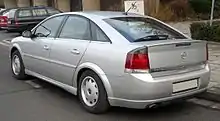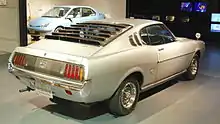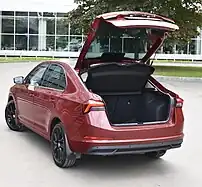A liftback is a variation of a hatchback car body style, with a more gently sloping roofline, roughly between 45 and 10 degrees, whereas traditional or archetypal hatchback designs tend to use a 45 degree to near vertical slope on the top-hinged tailgate (often called, and even counted as, a rear 'door' on hatchbacks).
As such, a liftback is essentially a hatchback with a gently sloping roof, with a side profile like that of fastback sedans, from an auto styling perspective. Some liftbacks, especially two-door models, may also have an appearance similar to a coupe, but with a boot / trunk tailgate hinged at the roof end, that is lifted including the rear window to open. Carmaker Saab used this in the marketing of their 900 liftback models, by calling them Combi coupé.
The liftback design combines a sedan or coupé with the rear hatch versatility of a hatchback. Liftbacks generally have more cargo space than the typically shorter bodied hatchbacks, and more space-use flexibility than conventional three-box sedans – but don't offer the space of a more square and boxy station wagon / estate variant of the same model. The aerodynamics of liftbacks can be more closely tear-drop shaped than those of hatchbacks, which due to their steeper down-sloped rears, more often end with a type of Kammback.
History
In 1973, Toyota invented the liftback term to describe the sloping roofline variation of the Celica with a tailgate hinged at the roof, as opposed to the regular hardtop coupe variation which was introduced three years earlier.[1][2][3] As its roofline slope is uninterrupted, it can also be defined as a fastback-styled hatchback.
Liftback versus fastback
The term fastback is not interchangeable with liftback. A liftback is defined as having a tailgate that is hinged from the roof, similarly to a hatchback, whereas a fastback is a broad styling term used to describe any car with an uninterrupted slope in the roofline from the roof to the rear bumper. Thus, although some liftbacks are fastbacks, not all liftbacks are necessarily fastbacks. Additionally, some fastbacks have a tailgate hinged below a fixed rear window, which is not characteristic of a liftback.[4] [5][6]
Some feel the slope of the rear window is a key determinant in the term liftback, in which the rear cargo door, or hatch, is horizontally angled. As a result, the hatch is lifted more upwards than backwards to open, a lifting action.[7]
Europe


Liftbacks were the mainstay of manufacturers' D-segment offerings in Europe in the 1990s to late 2000s, having become popular in the 1980s. It was common for manufacturers to offer the same D-segment model in three different body styles: a 4-door sedan, a 5-door liftback, and a 5-door station wagon. Such models included the Ford Mondeo, the Mazda 626 and 6, the Nissan Primera, the Opel Vectra and Insignia, and the Toyota Carina and Avensis. There were also models in this market segment available only as a 5-door liftback or a 4-door sedan, and models available only as a 5-door liftback or a 5-door station wagon. Often, the liftback and the sedan shared the same wheelbase and the same overall length, and the full rear overhang length of a conventional sedan trunk was retained on the five-door liftback version of the car.
The term was sometimes used for marketing purposes, among others, by Toyota, for example, to distinguish between two 5-door versions of the E90 series Corolla sold in Europe, one of which was a conventional 5-door hatchback with a nearly vertical rear hatch while the other one was a 5-door liftback.
Audi, BMW and Mercedes-Benz were not part of this trend in the 1990s, as they did not offer their D-segment or executive cars as 5-door liftbacks back then. However, starting around 2009, Audi and BMW started to sell liftback versions of some of their vehicles but with their own marketing terms, referring to them as Sportback (Audi) or Gran Turismo/Gran Coupé (BMW). This occurred not long after some other manufacturers started to retire D-segment liftbacks from their European lineup.
The second-generation Škoda Superb, produced from 2008 until 2015, is a car that functions both as a hatchback and a sedan. It features a Twindoor trunk lid that can be opened using hinges located below the rear glass, or together with the rear glass using hinges at the roof.[8]
See also
References
- 1 2 Sobran, Alex (15 May 2017). "This Toyota Celica Liftback GT Beautifully Couples Japanese And American Design". Petrolicious (U.S.). Retrieved 7 September 2020.
- 1 2 Koch, Jeff (1 January 2016). "1971-'77 Toyota Celica". Hemmings Motor News (U.S.). Retrieved 7 September 2020.
- 1 2 Fets, Jim (3 December 2010). "Collectible Classic: 1976-1977 Toyota Celica GT Liftback". Automobile Magazine (U.S.). Retrieved 7 September 2020.
- ↑ Flammang, James M. (1990). Standard Catalog of American Cars, 1976-1986. Krause Publications. p. viii. ISBN 9780873411332. Retrieved 1 March 2016.
- ↑ "fastback". Merriam-Webster Online Dictionary. Retrieved 1 March 2016.
- ↑ "fastback". The Oxford Pocket Dictionary of Current English. Retrieved 1 March 2016.
- ↑ Jaza, Reza N. (2008). Vehicle dynamics: theory and applications. Springer-Verlag. pp. 30–31. ISBN 978-0-387-74243-4. Retrieved 3 March 2014.
A hatchback car is called a liftback when the opening area is very sloped and is lifted up to open.
- ↑ "YouTube video".


.jpg.webp)